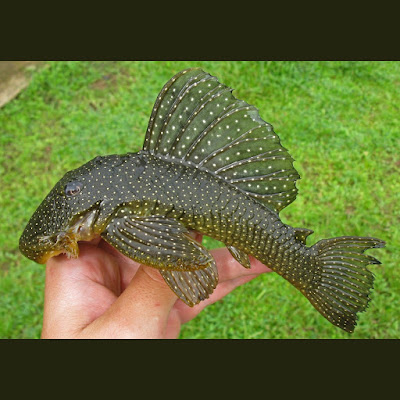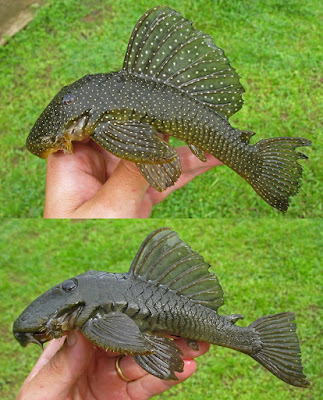[Most Recent Entries] [Calendar View]
Friday, September 20th, 2019
| Time | Event | ||||
| 2:08a | [Ichthyology • 2019] Baryancistrus micropunctatus & B. hadrostomus • Two New Species of the Armored Catfish Genus Baryancistrus Rapp Py-Daniel, 1989 (Siluriformes: Loricariidae) from Jari River, Amazon Basin, Brazil
Abstract Two new species of the suckermouth armored catfish genus Baryancistrus are described from the Jari River basin, at the border of Pará and Amapá states, Brazil. The new species are the first representatives of the genus described from rivers draining the Guiana shield, and can be distinguished from their congeners by color pattern and a combination of nonexclusive characters. Baryancistrus micropunctatus, new species, has a color pattern similar to B. longipinnis from the Tocantins River, whereas Baryancistrus hadrostomus, new species, has a color pattern that is unique for the genus, with a gray to black body covered by small and widely spaced white points. The first exemplars of the two new species were collected in the late 1980s by INPA ichthyological staff, and in 2007 additional materials were collected by the Museu de Zoologia da Universidade de São Paulo (MZUSP), providing a foundation for this description of the new species. Etymology.—The specific name micropunctatus is a combination of the Latin micro, meaning small, and punctatus, meaning dots, in reference to the small dots over the whole body in this species. An adjective. Baryancistrus hadrostomus, new species Etymology.— The specific name, hadrostomus, is from the Greek hadros, meaning ‘‘well developed, large,’’ and stoma, meaning ‘‘mouth,’’ in allusion to the extremely large oral disk in this species. An adjective. Renildo Ribeiro de Oliveira, Lúcia Rapp Py-Daniel and Osvaldo Takeshi Oyakawa. 2019. Two New Species of the Armored Catfish Genus Baryancistrus Rapp Py-Daniel, 1989 (Siluriformes: Loricariidae) from Jari River, Amazon Basin, Brazil. Copeia. 107(3); 481-492. DOI: 10.1643/CI-19-201 | ||||
| 8:58a | [Herpetology • 2019] Phymaturus fiambala • A New Species of Lizard (Iguania: Liolaemidae: Phymaturus) Endemic to Sierra de Fiambalá, Northwestern Argentina. Integrated Taxonomy Using Morphology and DNA Sequences: Reporting Variation Within the antofagast
The northernmost distributed group of lizards belonging to Phymaturus occurs in rocky outcrops of the Puna region between 3600–4200 m in Argentina. In a recent phylogenetic study based on morphological and genetic information, the monophyly of this small lineage was corroborated. This group is formed by Phymaturus antofagastensis, P. laurenti, P. denotatus, P. mallimaccii and a population of uncertain taxonomic status until the present study. After obtaining new samples and observations, we described a new species belonging to this lineage that is known only from Sierra de Fiambalá, being the species of Phymaturus living at the highest elevation ever recorded (4500 m). Males have a homogeneous yellow dorsum and lack melanic coloration over their heads, a phenomenon found in males of most species of the palluma group. We provide a detailed diagnosis, including characters from the squamation, coloration and significant differences found among continuous characters (ANOVA). Furthermore, we present genetic distances among members of the mallimaccii subclade based on sequences of the cytb marker. We provide color photos showing pattern variation of males and females. We reanalyze the phylogenetic relationships within the entire palluma group and update info on all members of the antofagastensis lineage based on new samples and make a better supported hypothesis. We also evaluate the phylogenetic position of the new taxon. Key words: Phymaturus fiambala sp. nov., Taxonomy, Squamata, Liolaemidae, Argentina. TAXONOMY: Family Liolaemidae Frost and Etheridge, 1989 Genus Phymaturus Gravenhorst, 1838 Phymaturus fiambala sp. nov. Lobo, Hibbard, Quipildor & Valdecantos Phymaturus sp5: Lobo et al. 2012: 21. Phymaturus sp. fia: Lobo et al. 2016: 650.
Diagnosis: Phymaturus fiambala sp. nov. Doral pattern with very thin spray, throats and chests light gray, rostral scales always undivided. Males with enlarged postcloacal scales, females with slender white transversal lines over trunk, enlarged scales on posterior gular fold, a patch of enlarged scales between gular folds evident, vertebral stripe absent. ... Etymology: The species inhabits Sierra de Fiambalá (Fiambalá mountains). The toponym Fiambalá comes from an ancient language (Cacán) of natives who lived in northwestern Argentina before Quechua (Inca) and Spanish became dominant. “Cacán” voice: fiambalao (fiambal = wind; ao = house, place), meaning “house of winds”. CONCLUSIONS: Phymaturus fiambala sp. nov. belongs to the antofagastensis lineage because it shares synapomorphies with all other members of the lineage: four discrete and three continuous characters (presence of flank color in females, loss of scale organ in mental, dark sides of neck speckled with small white spots among them) plus eight DNA changes. Phymaturus fiambala sp. nov. males exhibit yellow tails continuing the same color of trunks, different from all other members of the mallimaccii subclade, which is composed of males that exhibit brown tails (yellow tails are found in the vociferator clade, and the roigorum subclade). Furthermore, we found morphological and molecular evidence that allows us to differentiate P. fiambala sp. nov. from other species within antofagastensis lineage. Our present phylogenetic analysis provides a new hypothesis of relationships within the mallimaccii subclade that allow for more confident studies on evolutionary comparisons and the biogeography of these Andean lizards in the future. Lobo Fernando, Thomas Hibbard, Matías Quipildor and Soledad Valdecantos. 2019. A New Species of Lizard Endemic to Sierra de Fiambalá, Northwestern Argentina (Iguania: Liolaemidae: Phymaturus). Integrated Taxonomy Using Morphology and DNA Sequences: Reporting Variation Within the antofagastensis Lineage. Zool. Stud. 58:.. DOI: 10.6620/ZS.2019.58-20 |
| << Previous Day |
2019/09/20 [Calendar] |
Next Day >> |







